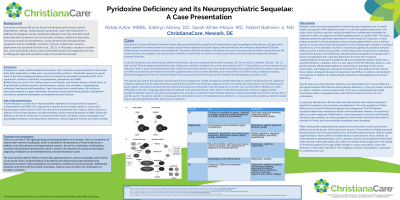Obesity, Nutrition, and Eating Disorders
(113) Pyridoxine Deficiency and it's Neuropsychiatric Sequelae

- RA
Ridda Azhar, MBBS (she/her/hers)
Resident Physician
Christiana Care
Wilmington, Delaware - SM
Sarah K. Mooar, MD, MA
Resident physician
ChristianaCare
Philadelphia, Pennsylvania 
Kathryn Shirley, DO
Resident Physician
Christiana Care
Newark, Delaware- RB
Robert F. Bahnsen, Jr., MD
Medical Director
ChristianaCare
Wilmington, Delaware
Presenting Author(s)
Co-Author(s)
We present a 53-year-old African American female with past medical history significant for hypertension, gastroesophageal reflux disease, past psychiatric history significant for heavy alcohol use and past surgical history significant for gastric bypass, who presented to the emergency department (ED) with bilateral lower extremity weakness and multiple falls. During the initial ED evaluation, the patient was noted to be paranoid and fearful, stating that she felt unsafe at home. Her daughter, who was present at bedside, revealed that her mother's mental status had recently been deteriorating with increased paranoid delusions.
In the ED, the patient was worked up for altered mental status, labs were significant for positive urinalysis, AST 59, normal ALT, Alk phos 138 and T. Bili 1.4 with normal TSH and negative blood alcohol level. Patient was started on antibiotics for urinary tract infection (UTI). CT head without contrast showed chronic infarction, with no acute intracranial abnormality. Given history of heavy alcohol use, acute alcohol withdrawal was suspected, therefore, patient was placed on CIWA and started on both thiamine and folate supplementation. She was then admitted to the medical floor for further workup. Additional leading differential diagnoses at that time included multiple sclerosis given positive family history and metabolic encephalopathy secondary to UTI.
The patient was seen by the psychiatry consult team for the management of AMS secondary to alcohol dependence, further complicated by UTI. Additional collateral obtained from the patient's family revealed that the patient was drinking 3-4 glasses of wine and eating only small amounts of food. The patient admitted that she had lost 35 pounds unintentionally in the preceding 5 to 6 months. She scored 17/35 on MOCA (v 8.1) with difficulties in attention, language, abstraction and delayed recall with overall poor effort. Given no formal past psychiatric history to suggest primary psychiatric disorder, patient's psychosis was thought to be secondary to vitamin/mineral nutrient deficiency. Vitamins B1 and B6 were found to be low, B6 < 2 and B1 was 54. The patient started on intravenous (IV) multivitamin on day 3 of hospitalization in addition to a 7-day course of IV pyridoxine. Patient's mental status improved significantly after this course of treatment.
Overall, low levels of vitamin B6 can be found in individuals with chronic alcohol dependence, obesity, malabsorption syndromes, and renal impairment in addition to iatrogenic causes. Pyridoxine deficiency not only manifests itself physically with symptoms such as mucositis, cheilosis, seborrheic dermatitis, microcytic anemia and paresthesia, it may present with neuropsychiatric symptoms such as irritability, confusion, memory impairment, seizures, depression and psychosis (Toriumi et al., 2021). In this poster, we plan to review less commonly known vitamin and mineral deficiencies with exploration of how to distinguish signs and symptoms, how to test and how to treat. Toriumi K, Miyashita M, Suzuki K, Yamasaki N, Yasumura M, Horiuchi Y, Yoshikawa A, Asakura M, Usui N, Itokawa M, Arai M. Vitamin B6 deficiency hyperactivates the noradrenergic system, leading to social deficits and cognitive impairment. Transl Psychiatry. 2021 May 3;11(1):262. doi: 10.1038/s41398-021-01381-z. PMID: 33941768; PMCID: PMC8093222.
Presentation Eligibility: Not previously published or presented
Diversity, Equity, and Inclusion: The issue of nutritional deficiencies is prevalent in marginalized and underserved communities, these can include specific vitamins/mineral deficiencies. These deficiency can often present with neuropsychiatric sequelae. It important to recognize and treat these deficiencies promptly.

